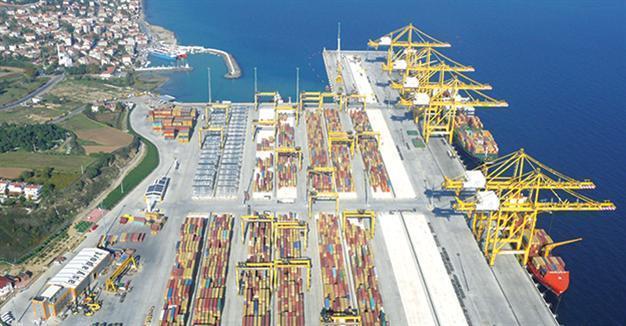Ports eye expansion as ‘mega-ships’ appear
ISTANBUL - Anadolu Agency

Asyaport in Tekirdağ, the biggest port in Turkey established on a 300,000-square-meter area, is the only Turkish port that is able to serve mega-ships, while over 20 ports can accommodate container ships with a 14,000-TEU capacity.
Around the world, demand for “mega-ships” has increased in recent years and countries such as Turkey have lacked seaports with the sufficient size and logistics to take them in.Today, the largest ship is about the size of the Empire State building, i.e. 400 meters long or 19,200 TEU - the twenty-foot equivalent unit that is defined throughout the world to describe the capacity of container ships. In 1995, the largest vessel was 6,600 TEU.
Mega-ships decrease transportation costs by half, accumulating more cargo and saving fuel and manpower.
“Bigger ships always mean more profit,” says Erol Yücel, chairman of Martı Shipping and Ship Management Co. Inc. “They do not have any drawbacks either in economic or environmental aspects.”
But mega-ships also mean “deeper and longer docks as well as bigger container cranes, wider storage space, and a more developed logistics infrastructure,” says Soner Esmer, vice chairman of the department of logistics management at Dokuz Eylül University Maritime Faculty in the western province of İzmir.
Ersel Zafer Oral, a consultant in the Izmir office of the Turkish Chamber of Shipping, adds inner-city ports cannot operate at full capacity as a result of logistics services in the hinterland.
Currently, mega-ships that cannot dock at Turkish ports head to Italy’s Port of Gioia Tauro, Spain’s port of Algeciras, Malta’s Marsaxlokk, Egypt’s Port Said or Morocco’s Tanger Med.
“They are all on the main trade route between the Far East and Europe,” says Esmer.
His colleague Oral agrees: “There is no other way to trade with China and America [than by sea.] The only alternative to sea transport is the border trade with neighbor countries.”
“Mega-ships come into mega-ports, which means a significant amount of loading and a significant economic value,” Esmer says. “If a mega-ship goes into a country, it means that country has an important geographical position or an intense load capacity and has suitable ports with enough length, depth, and equipment.”
He pointed out that with larger ports in Turkey, “more people will be employed and a considerable amount of foreign exchange inflow will be ensured.”
“Access to international markets will also be easier,” he said.
Turkey is surrounded by water on three sides. Half of the country’s exports travel by sea, according to the Turkish Statistics Institute. The total amount of exports in 2014 was $157 billion; the proportion carried out by sea represented $86 billion, more than half.
One port for mega-ships
Currently, over 20 ports in Turkey can accommodate container ships with a 14,000-TEU capacity --rarely larger– and, mostly, feeder ships, the Turkish Ship owners’ Association says in a report sent to the Anadolu Agency. Ship owner Yücel points to the need for larger ports in Turkey and says Asyaport in the northwestern Tekirdağ province is the only convenient one for mega-ships.
Asyaport has been operational since July 8, 2015, and is the biggest port in Turkey. It is established on a 300,000-square-meter area “with a capacity to handle both the current container ships and the ones to be built in a decade,” says Captain Kadir Uzun, the port’s operation manager.
“The largest container vessel today, MSC OSCAR [with a capacity of 19,224 TEU] can easily dock at Asyaport,” he says.
Although not adapted for the larger container vessel, Marport in Istanbul can nevertheless serve for ships with a capacity of up to 16,000 TEU. Investment in the port continues to increase the capacity for larger ships, says Özgür Kalelioğlu, vice president for Port and Terminal Services of Arkas Holding.
The world’s biggest shipping companies, however, have already ordered the largest container ships ever in the first half of 2015, the Port Operators Association of Turkey stipulates in an August sectorial report. The size of those ships is to reach 20,000 TEU.
While mega-ships’ importance will undoubtedly increase in the coming years, they will also bring another need, Soner Esmer adds.
“With the ongoing investment in Turkish ports, we will also be serving for ever-expanding feeder ships --which collect containers from different ports and transport them to central container terminals where they are loaded to bigger vessels,” he says noting Turkey’s advantageous location between the Black Sea and the Mediterranean route.
















